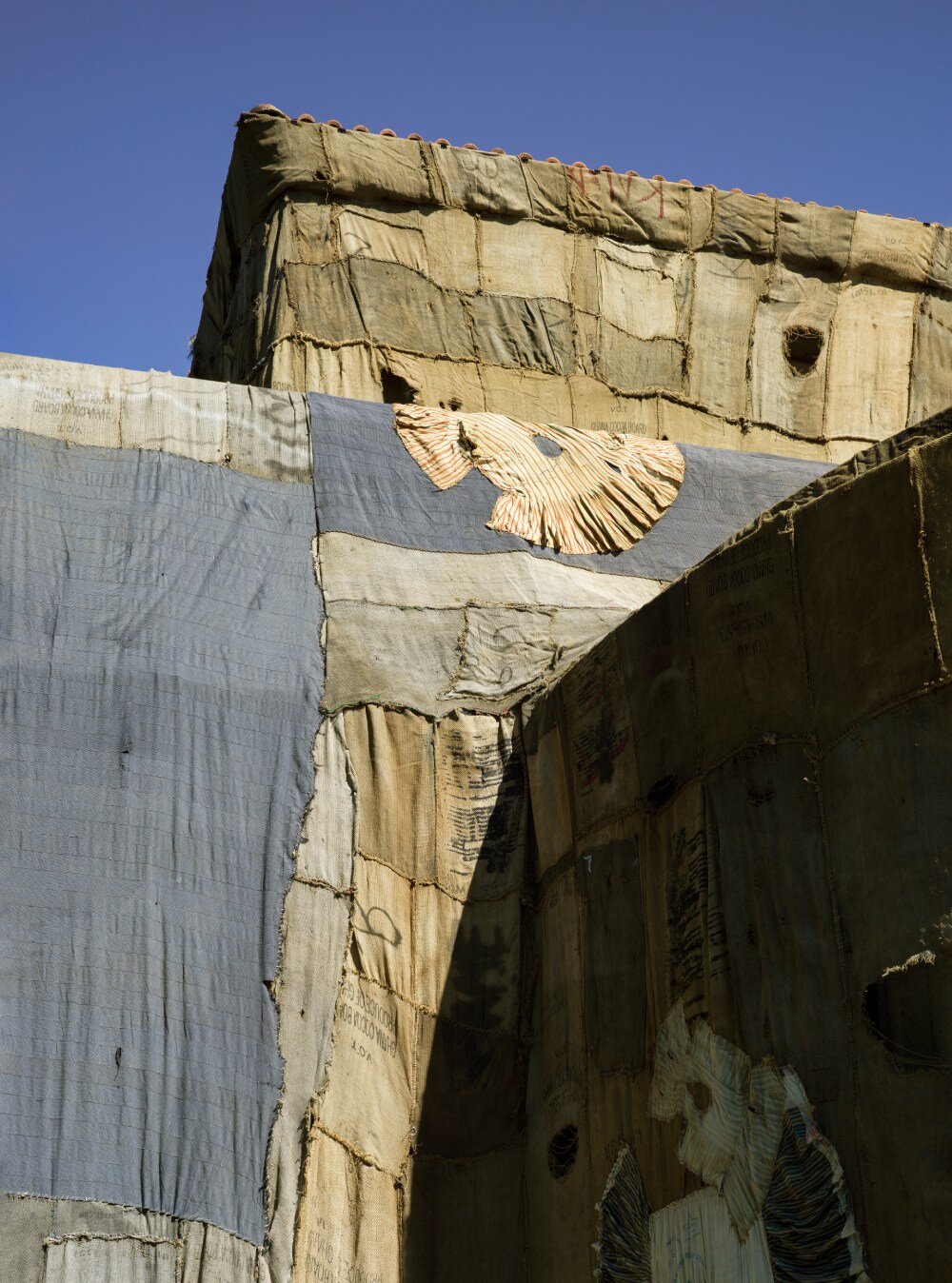the jute sack veil marks the kunsthalle bern’s reopening
Ibrahim Mahama conceals the Kunsthalle Bern in Switzerland behind a veil of jute sacks, marking a moment of transition for the historic gallery. The installation coincides with the Kunsthalle’s upcoming reopening and its shift toward a broader institutional reinvention, while echoing one of the most iconic moments in its history: the translucent 1968 wrap by Christo and Jeanne-Claude celebrating its 50th anniversary.
Mahama’s intervention transforms the building’s exterior into a textured, earth-toned skin, layering global histories of labor, trade, and material exchange onto the facade. The historic jute sack, laden with connotations of colonial legacies and economic networks, becomes his primary medium, assembled to introduce a rough presence that embeds the structure within larger social conversations. The installation will remain on view through June 1st as the Kunsthalle moves toward a full reopening with an ambitious program featuring exhibitions by artists including Melvin Edwards and Tuli Mekondjo, alongside events and performances.

all images courtesy Cedric Mussano
ibrahim mahama questions flows of labor, value, and power
This new commission arrives at a pivotal moment for Kunsthalle Bern. As the institution undergoes renovations to improve safety, accessibility, and environmental performance, it has embraced the opportunity to rethink its mission. Under the leadership of director iLiana Fokianaki, the institution has been engaged in a yearlong process of what it has termed ‘fermentation’, referring to a radical rethinking of its operational, curatorial, and administrative practices by drawing from the ecological principles of permaculture. As the building transforms physically, so too does the institution’s vision: toward a more inclusive, model that considers its social and ecological responsibilities in the context of the environment and global cultural shifts — ‘A ‘work in progress’ where our new vision for an institution of the future emerges: permeable and with access for all,’ as the team notes.
For Ibrahim Mahama, the opportunity to design a veil that marks this moment of transition signaled a chance to interrogate the flows of labor, value, and power that shape global histories, while situating the Kunsthalle within those networks. Known internationally for his large-scale installations made from found and repurposed materials, the Ghanian artist works with the histories embedded in everyday objects. His signature material, the jute sack, carries particular resonance in this project. Used in his native country to transport cocoa, the sacks bear the marks of a context deeply intertwined with Swiss economic history. Manufactured in Southeast Asia, shipped to Ghana by the Ghana Cocoa Board, used first for cocoa, then sold on to local rice and corn traders and ultimately recycled for charcoal transport, the sacks here become an archive of labor, trade, and environmental change.

Ibrahim Mahama’s intervention at the Kunsthalle Bern in Switzerland
a record of collective labor
Where Christo and Jeanne-Claude’s wrap was a formal exploration of concealment and transformation, Ibrahim Mahama’s version layers in histories of colonialism, global capitalism, and ecological crisis through this material. The work also asks viewers to consider how institutions are shaped by the legacies they inherit, whether in architecture, art history, or trade, and how those legacies might be opened up to critical reflection.
The jute sack, as Mahama explains, becomes a record of collective labor, ‘scarred’ by its passage through global circuits of commerce. The material’s own vulnerability, including its susceptibility to insect infestations that threaten up to 40% of harvest value, points to larger systems of extraction, overproduction, and ecological collapse. Seen in this light, even the smallest actors — insects — become agents in disrupting the flows of global capital, reframing how we understand agency and resistance in the context of environmental degradation.

concealed behind a veil of jute sacks
The Kunsthalle’s upcoming program, culminating in a full relaunch in spring 2025, will continue to develop these questions. Fokianaki’s curatorial approach, too, supports this by foregrounding the institution as a site of permeability and public accountability. The renovation phase has been used as an active chance to reconsider why the institution exists, for whom it operates, and how it can become a ‘home’ in an era marked by ecological and social uncertainty.

used in Ghana to transport cocoa, the sacks bear a context deeply intertwined with Swiss economic history

the installation coincides with the Kunsthalle’s upcoming reopening and its shift toward an institutional reinvention
project info:
name: Kunsthalle Bern wrap
artist: Ibrahim Mahama
location: Switzerland
photographer: Cedric Mussano










